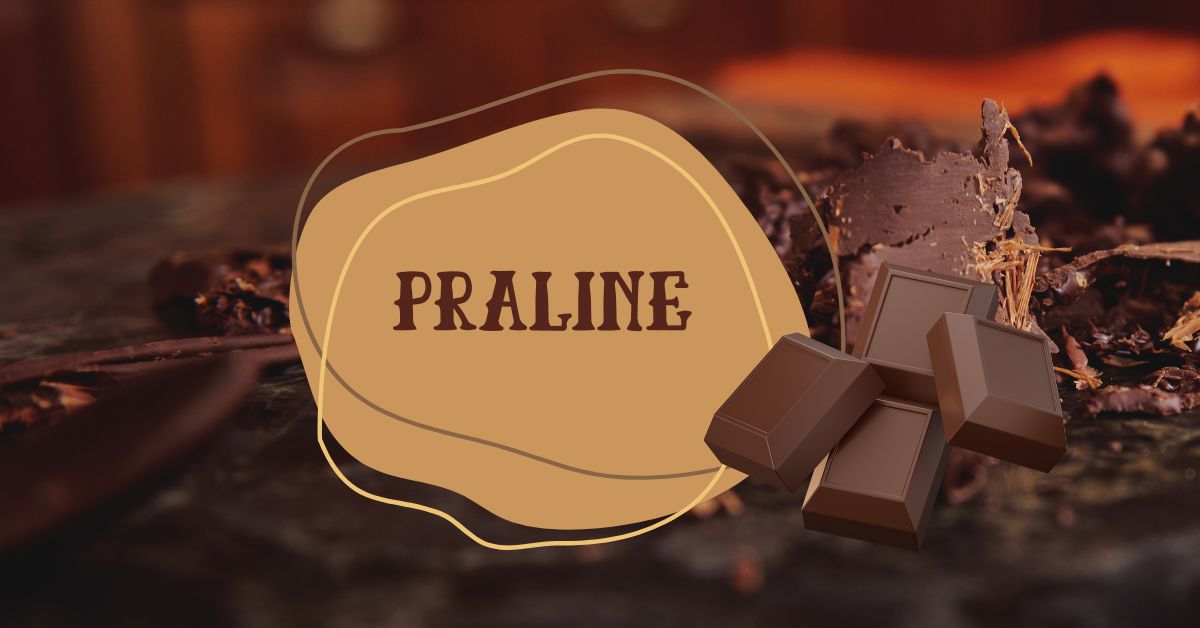Praline, with its irresistible blend of sugar, nuts, and butter, has captured the hearts of dessert lovers for centuries. Whether enjoyed as a creamy confection, a crunchy candy, or a smooth filling, praline embodies indulgence in every bite. This beloved treat has a fascinating history, a variety of regional interpretations, and a deep cultural significance that extends beyond its sweet taste. Let’s dive into the nutty, caramelized world of pralines and explore what makes them a timeless favorite.
The Origin of Praline
The history of praline dates back to 17th-century France, where it was first crafted by the personal chef of César, Duke of Choiseul-Praslin. Legend has it that the chef accidentally dropped almonds into boiling caramelized sugar, creating the earliest form of praline. The delightful accident turned into a culinary innovation that quickly spread across Europe. The confection was later named “praline” in honor of the Duke himself, linking his name to one of the sweetest creations in dessert history.
Evolution of Praline Around the World
As praline spread from France to other parts of the world, it evolved to suit local tastes and ingredients. The French praline, known for its caramelized nuts and crisp texture, laid the foundation for the many variations that followed. When the recipe reached New Orleans with French settlers, local chefs transformed it by using pecans instead of almonds and adding cream to create a softer, fudge-like consistency. Belgian chocolatiers took praline in a different direction altogether, using it as a smooth, nut-based filling inside their famous chocolate shells. Each adaptation brought something unique, making praline a global delicacy.
Ingredients That Define Praline
At its core, praline is made from just a few simple ingredients—nuts, sugar, and sometimes butter or cream—but the quality of these components determines the final taste. The choice of nuts is crucial, with almonds, pecans, and hazelnuts being the most popular. Sugar is typically caramelized to achieve that rich golden-brown sweetness, while butter or cream enhances smoothness and adds depth to the flavor. The interplay between these ingredients creates the iconic melt-in-your-mouth sensation that praline lovers adore.
French Praline: The Original Classic
The French praline is crisp, light, and deeply aromatic. Traditionally, it is made by coating almonds or hazelnuts in caramelized sugar and allowing them to harden. The result is a brittle texture with a roasted nutty flavor complemented by the sweetness of caramel. French chefs often grind these pralines into a powder known as “praliné,” which is then used as a base for desserts such as mousses, pastries, and chocolates. This version celebrates simplicity, precision, and a perfect balance between nutty and sweet.
Belgian Praline: A Chocolate Dream
Belgian praline revolutionized the world of chocolates. Unlike the French version, Belgian praline is not a candy but a filling made from finely ground nuts blended with sugar and cocoa butter. It was first created by chocolatier Jean Neuhaus in 1912, who used it to fill hollow chocolate shells. This innovation led to the birth of the modern filled chocolate, often referred to as a “Belgian praline.” These confections come in countless flavors and shapes, combining smooth nut pastes with silky chocolate coatings for an unmatched luxury treat.
American Praline: The Southern Sweetheart
In the American South, praline took on a new personality. French settlers in Louisiana adapted their traditional recipe using native pecans and local ingredients such as brown sugar and cream. The result was a softer, fudge-like candy with a rich, buttery flavor. New Orleans pralines became an iconic Southern treat, often sold fresh in candy shops and tourist markets. The combination of creamy texture and toasted pecans makes the American praline distinct and deeply comforting—a true taste of Southern hospitality.
The Science Behind Perfect Praline
Creating praline is both an art and a science. The key lies in controlling the caramelization process and the temperature of the sugar. When sugar melts, it goes through several stages—from thread to soft ball to hard crack—each producing different textures. Achieving the right temperature ensures that the praline sets perfectly without becoming too brittle or too chewy. The Maillard reaction, which occurs when sugar interacts with proteins in nuts, enhances flavor and gives praline its signature golden color. Precision in timing and heat control separates an average praline from a perfect one.
Cultural Significance of Praline
Beyond being a confection, praline holds cultural value in several regions. In France, it represents elegance and tradition, often served during celebrations or as a gourmet gift. In Belgium, praline is synonymous with fine chocolate craftsmanship, symbolizing luxury and refinement. In the American South, praline embodies warmth, community, and the rich culinary heritage of New Orleans. It’s more than candy—it’s a symbol of comfort, hospitality, and regional pride, bringing people together over shared sweetness.
How to Make Praline at Home
Making praline at home is surprisingly simple yet rewarding. The process begins by heating sugar until it caramelizes into a golden syrup. Then, nuts—typically almonds, pecans, or hazelnuts—are stirred in and coated evenly before being poured onto parchment paper to cool. For a creamier version, butter and cream are added to the mixture to create a soft, melt-in-the-mouth texture. Once cooled, pralines can be stored in airtight containers or used as toppings for desserts. Homemade praline not only tastes fresher but also allows customization according to personal taste preferences.
Praline in Modern Desserts
Today, praline is a staple ingredient in the culinary world, used to elevate a variety of desserts. From praline ice cream and praline cheesecake to praline tarts and truffles, its versatility knows no bounds. Pastry chefs use crushed pralines to add crunch to mousses and parfaits, while chocolatiers blend pra’line paste into ganache fillings for an extra layer of indulgence. The combination of caramelized sweetness and nutty richness adds depth to both simple and sophisticated desserts, making praline a timeless favorite.
Health Benefits of Praline Ingredients
While praline is undeniably a treat, its core ingredients—nuts—offer several health benefits. Nuts like almonds and pecans are rich in healthy fats, proteins, and antioxidants. They support heart health, improve brain function, and provide essential vitamins such as E and B6. Of course, the sugar content in praline should be enjoyed in moderation, but the inclusion of nuts makes it a slightly more wholesome indulgence compared to other confections. When made with natural sweeteners and minimal additives, pra’line can be both delightful and somewhat nutritious.
Praline in Popular Culture
Praline has found its way into popular culture as a symbol of sophistication and nostalgia. From mentions in literature to appearances in culinary television shows, praline evokes images of elegance and comfort. In the Southern United States, it is deeply associated with festivals, family gatherings, and traditions passed down through generations. European chocolatiers, on the other hand, use pra’line as a signature flavor in luxury brands, representing craftsmanship and decadence. This cultural presence reflects praline’s enduring appeal across generations and borders.
The Art of Pairing Praline
Praline pairs beautifully with a wide range of flavors. Its nutty caramel sweetness complements bitter coffee, rich chocolate, and creamy vanilla perfectly. It can be paired with fruits like banana, pear, or raspberry to balance sweetness with acidity. For beverages, pra’line harmonizes well with cappuccinos, dessert wines, and even whiskey, creating an elevated tasting experience. The balance of flavors enhances the overall sensory pleasure, making praline an excellent component in gourmet pairings and tasting menus.
Sustainability in Praline Production
Modern confectioners are increasingly focusing on sustainability in praline production. From sourcing ethically grown nuts to using fair-trade sugar and eco-friendly packaging, the industry is evolving. Many chocolatiers are adopting transparent supply chains to ensure farmers are fairly compensated. Sustainable pra’line not only supports the environment but also enhances quality, as responsibly sourced ingredients tend to be fresher and more flavorful. This growing awareness is shaping a more ethical and eco-conscious future for the confectionery industry.
Conclusion
Praline is more than just a sweet treat—it’s a celebration of flavor, history, and craftsmanship. From its humble beginnings in a French kitchen to its worldwide fame as a symbol of indulgence, pra’line has stood the test of time. Whether you prefer the crisp French version, the creamy Southern variation, or the luxurious Belgian chocolate-filled pra’line, each bite tells a story of cultural evolution and culinary artistry. Its simplicity, versatility, and rich taste make it a confection that continues to delight taste buds around the globe. So next time you savor a praline, remember—you’re tasting a piece of history wrapped in sweetness.
FAQs
What is praline made of?
Praline is typically made from nuts such as almonds, pecans, or hazelnuts coated in caramelized sugar. Some variations include butter, cream, or chocolate.
What’s the difference between French and American pra’line?
French praline is crunchy and made with caramelized nuts, while American praline is softer and creamier, often made with pecans, brown sugar, and cream.
Can pra’line be used in baking?
Yes, praline can be crushed and added to cakes, pastries, and ice creams to enhance texture and flavor.
How should pra’line be stored?
Praline should be stored in an airtight container at room temperature to prevent moisture from softening it.
Is pra’line gluten-free?
Most traditional pralines are naturally gluten-free, but it’s always best to check ingredient labels for any added gluten-containing ingredients.












